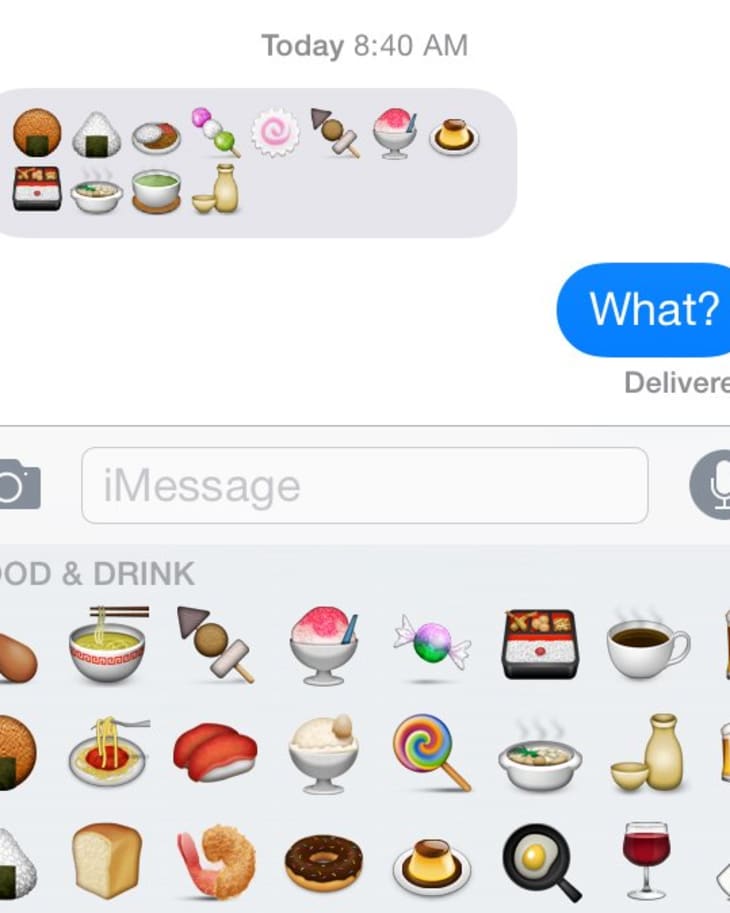What All Those Mysterious Japanese Food Emojis Really Mean
Like many things cute and useful, emoji originated in Japan, which means many of the icons are specific to Japanese culture. With food being a vital part of the culture — there are at least 80,000 restaurants in Tokyo alone, according to Frommer’s — it’s no surprise that there are quite a few food and drink emoji that may leave you scratching your head. What’s with all the shapes on sticks? Is that flan? And what’s in that delicious-looking rice dish?
Our guide to Japanese food emoji answers those questions and many more. Itadakimasu!*
Rice Cracker
Sembei (also spelled senbei) are rice crackers which are often brushed with a soy sauce mixture and grilled over charcoal, then wrapped with a piece of nori. You can find them at festivals and other tourist destinations.
•
Rice Ball
Onigiri are round or triangular balls of nori-wrapped rice stuffed with cooked meat, fish, or other flavorful ingredients, such as umeboshi (pickled plum). They are a popular travel food and can be purchased at supermarkets, convenience stores, and train stations.
•
Curry and Rice
Kare-raisu (“curry rice”) is the Japanese version of Indian curry, which was brought to Japan by the British during the Meiji era (1868-1912). In the dish, thick curry sauce with vegetables and meat is served over short-grain rice, usually accompanied by pickles.
•
Dango
Dango are a type of sweet made from rice flour, with a texture similar to mochi. There are many different types; the pink, white, and green dango are called bocchan dango.
•
Oden
Oden is a type of Japanese stew typically eaten in winter and includes a wide variety of ingredients, such as fish cakes, fried tofu, and konnyaku. Sometimes the ingredients are skewered rather than eaten from a bowl.
•
Fish Cake
Naruto (also called narutomaki) is a type of fish cake with a distinctive pink swirl in the middle, named after the tidal whirlpools of the Naruto Strait. Made from pureed whitefish that is molded and steamed, slices of naruto are often served in dishes like ramen and oden.
•
Shaved Ice
Kakigori is a dessert of shaved ice topped with flavored syrup and other additions, such as sweetened condensed milk, sweet azuki beans, and/or ice cream. The ice has a soft, fluffy texture, and the dessert is typically eaten with a spoon.
•
Custard
Purin (“pudding”) is a popular dessert in Japan, and although it comes in many flavors, the most basic version is a cold custard with caramel sauce, similar to Mexican flan.
•
Bento Box
A bento is a homemade or purchased meal packedin a box, usually consisting of rice with a variety of accompaniments such as cooked seafood, meat, vegetables or pickles. The little red circle on the rice is a pickled plum (umeboshi).
•
Pot of Food
Nabe is the Japanese version of a
hot pot
•
Green Tea
Matcha is a powdered green tea that is whisked with hot water using a special bamboo whisk and served in bowls at elaborate tea ceremonies in Japan, but can also be whisked at home for a more casual drink.
•
Sake Bottle and Cup
Sake is an alcoholic beverage made with fermented rice and served in small cups called choko, poured from a small flask called a tokkori. It can be served hot or cold, but expensive sake is generally served cold, to better experience its flavors and aromas.
•
Izakaya Lantern
You might not know this emoji is food-related, but red paper lanterns are traditionally associated with izakaya, casual Japanese pubs that serve alcohol and an assortment of food. Glowing red lanterns are usually hung outside these restaurants, letting patrons know food and drinks can be found inside.
*This phrase is said before starting to eat, something like “Bon appétit!”
